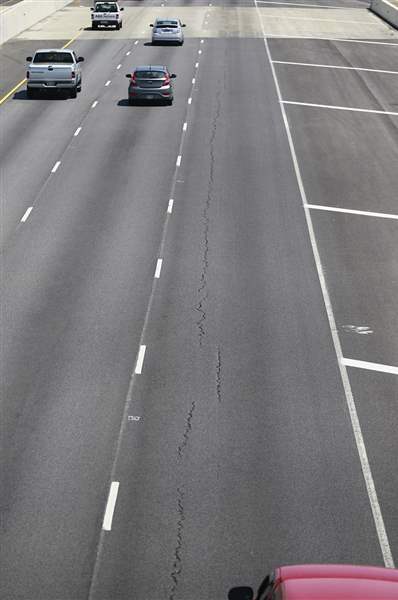
WEST TOLEDO
Cracks in recent I-475 work to be fixed, investigated
ODOT blames weather, not contractor for road surface
5/20/2014
The Ohio Department of Transportation is blaming frost heaves for cracks and uneven surface conditions on freshly rebuilt I-475 in West Toledo. That reconstruction project cost $64 million.
THE BLADE/LORI KING
Buy This Image

Audet
The Ohio Department of Transportation is blaming frost heaves for cracks and uneven surface conditions that formed during the winter on freshly rebuilt I-475 in West Toledo.
While an ODOT official said Monday that the cracks will be sealed during the next few weeks as part of other finish work for the freeway’s $64 million reconstruction and widening between I-75 and Rushland Avenue, a permanent repair isn’t planned for several years.
Todd Audet, the department’s district deputy director in Bowling Green, said the problem does not appear to represent any deficiency in the work done by E.S. Wagner, the I-475 project’s Toledo-based general contractor. How much the repairs will cost taxpayers is not yet known, but ODOT expects to pay for the work.
Mr. Audet also said it’s not yet totally clear whether how the road was built contributed to the problem, or if using more cement to stabilize it might help prevent similar problems with future projects.
Crews will take further samples from the roadway starting today, which ODOT and engineers at the University of Toledo and Ohio University will test to further isolate the problem’s cause.
The cracks occurred close to, and parallel with, lengthwise joints in I-475’s pavement at the dividing line between its reconstruction’s two phases, Mr. Audet said. Such joints are usually staggered between different pavement layers, he said, but for this project the staggering was particularly narrow because of ODOT’s desire to keep at least two lanes — and through most of the work zone, three — open at a time.
Engineers will check for any difference in the cement-soil mixture beneath road between the two construction phases because the newest pavement has shown the worst effects, he said. If not, then the joint between construction phases will be redesigned.
“Pavement design seems like such a simple thing,” Mr. Audet said. “And when you’re building over bedrock, it is. But when you’re building on top of a swamp, on top of clay, it becomes a science.”

The Ohio Department of Transportation is blaming frost heaves for cracks and uneven surface conditions on freshly rebuilt I-475 in West Toledo. That reconstruction project cost $64 million.
Furthermore, he said, the I-475 reconstruction was “designed for normal conditions, and we had anything but normal conditions the last 20 months for precipitation and temperature.”
Shad Sargand, a civil-engineering professor at Ohio University who will conduct his institution’s testing of the I-475 samples, praised the transportation department’s desire to nail down what caused the pavement problem so it doesn’t recur on other projects.
“So many things can happen that can affect the performance of pavement,” Mr. Sargand said.
Engineers are only starting to learn that environmental factors, such as weather and subsurface moisture, cause more damage to roadways than traffic does, the professor said.
“In the old days, we couldn’t measure moisture under the pavement, but now we have sensors that can do that for 10, 15 years,” he said.
Mr. Sargand declined to comment on how the roadway was designed, but said it’s plausible ODOT is a victim of bad luck that a severe winter, with record-shattering snowfall and sustained cold, hit Toledo immediately after the project’s completion.
Had such a winter not occurred until several years later, he said, much more of the sub-grade’s moisture would have drained away and the pavement could have held up much better.
“We expect there’s still moisture in the sub-grade,” Mr. Audet said, referring to the poorly draining clay soil beneath the roadway’s subsurface crushed stone. Sealing the cracks now, then waiting several years to give that moisture time to drain away before repaving the surface should improve ride quality, he said.
Lane closings for the pavement sampling, finish work, and crack sealing are scheduled for 7 p.m. to 6 a.m. nightly from today into June.
Between 10 p.m. today and 5 a.m. Wednesday, the ramps from northbound I-75 to westbound I-475 and from eastbound I-475 to northbound I-75 will be closed.
The ramp from eastbound I-475 to southbound I-75 will be closed during the same hours Wednesday night into Thursday.
Traffic will be detoured to the Phillips Avenue or Detroit Avenue interchanges, as appropriate, during those ramp closings.
The crack sealing and related minor pavement repair are expected to cost $50,000. Mr. Audet provided no estimate for the cost of later resurfacing, which he said would probably be added to ODOT’s upcoming contract to rebuild and widen I-75 between I-475 and Phillips.
Contact David Patch at: dpatch@theblade.com or 419-724-6094.